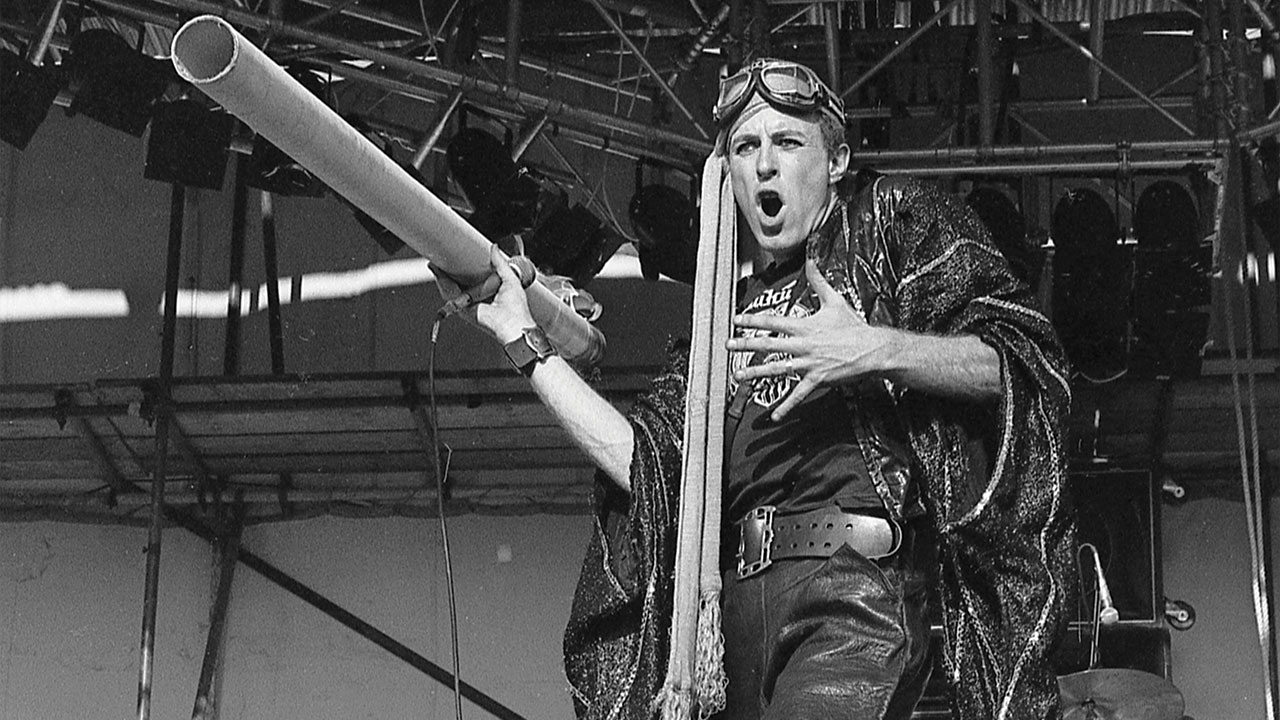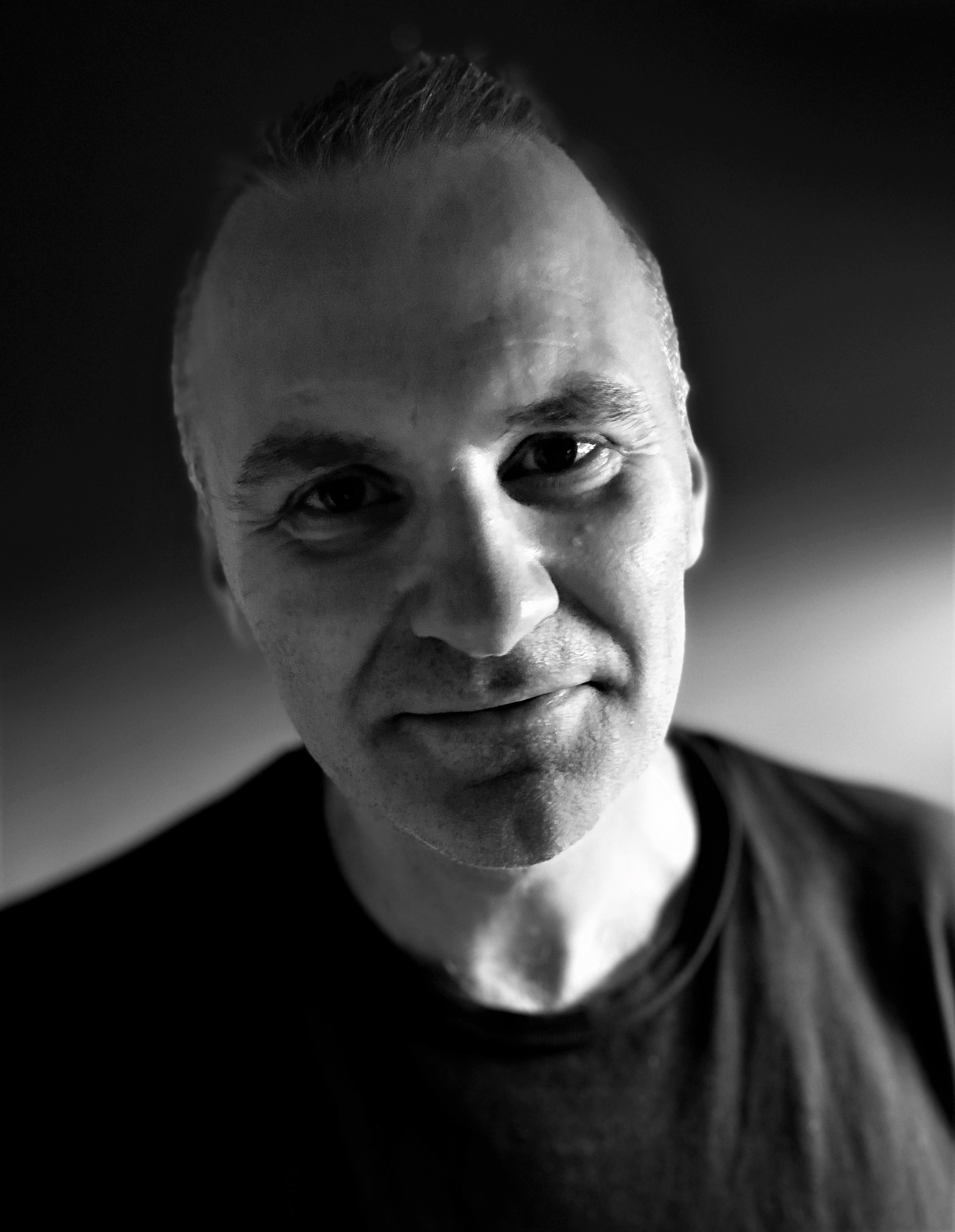It’s October 1977, and Robert Calvert – sci-fi poet, frontman extraordinaire and self-declared “hypo-manic” – is running down the middle of a road in Paris. He’s dressed in full military fatigues and is shouting at a car to stop. The car contains Calvert’s bandmates in Hawkwind, and is about to become stuck in a traffic jam. As startled passers-by look on, Calvert catches up with the car and tries to wrench its doors open – but they’re locked. He shouts at its occupants to let him in, but they all ignore him. When the traffic clears, the car drives off, leaving Calvert stranded in a sea of honking vehicles.
This isn’t the end of Calvert’s tenure with Hawkwind, but it’s where the line between playing a role and being taken over by it cracks wide open. He’s used the band as a canvas for expressing his own dreams and obsessions, developing a rich mythology for the band that resonates to this day. He depicts them as starfaring saviours of the earth and heralds of a new type of science-fiction music – but a combination of mental health problems and creative passion means Calvert lives constantly on the edge between fantasy and reality.
Born in South Africa in 1945, Calvert grows up in the English seaside resort of Margate. In his youth, he writes poetry and sings for local bands, all the time planning to join the RAF and fulfil his ambition of becoming a fighter pilot – unfortunately, a defective ear rules him out of flying planes. Instead, he becomes increasingly fascinated by the artistic possibilities of counter-cultural London. The underground magazine Friends publishes his writing, and with the help of his old friend Nik Turner, he moves into the heart of the alternative society – Ladbroke Grove.
Calvert checks out Turner’s band, intrigued by his friend’s description of them as playing ‘space rock’, and it’s not long before he’s performing onstage with Hawkwind. On May 26, 1971, he introduces their set at the Seven Sisters Club in London with a reading of his poem, Co-Pilots Of Spaceship Earth. Its words act as a manifesto for the band’s increasingly millenarian musical vision: the world teeters on the brink of destruction and only the void offers salvation.
Calvert’s sci-fi oratory injects an air of menacing theatricality into Hawkwind’s propulsive, cosmic psychedelia, and he becomes an official member in October 1971. But he’s already been busy conceptualising on their behalf, the most obvious fruits being The Hawkwind Log booklet that comes with their second album, In Search Of Space, where he imagines the band as ‘ancient astronauts’ returning to Earth to save the planet from itself. This vision of Hawkwind as galactic superheroes will have an enormous influence on both their public (and media) perception and the direction the band go in.
But the biggest impact that Calvert has on Hawkwind is his co-writing of their 1972 single, Silver Machine. A secret ode to his bicycle, which he doesn’t even appear on – his original vocal is overdubbed with Lemmy’s imperious bellow – it changes the band’s fortunes forever when it becomes a global hit, suddenly pitching them into rock’s premier league. It also gives them the financial muscle to realise an immersive multimedia live show that Calvert has been planning ever since climbing aboard the ship: the Space Ritual. “The basic idea is that a team of starfarers are in a state of suspended animation… the opera is a presentation of the dreams they’re having in deep space,” he explains. “It’s a mythological approach to what’s happening today… Rocket ships and interplanetary travel are a parallel with the heroic voyages of man in earlier times.”
The shows are unlike anything seen before on the UK gig circuit, a seamless meld of brain-melting music and visuals punctuated by atmospheric spoken-word interludes from Calvert. The most renowned of these is the Michael Moorcock-penned Sonic Attack, a blackly comic take on WWII public information films updated for the nuclear age, with Calvert’s icy voice full of contempt for the people he’s supposedly warning. Its ending – Calvert urging ‘Do not panic! Think only of yourself!’ over a throbbing beat – is Hawkwind at their most terrifying.
Moorcock – the science-fiction and fantasy writer who also sometimes appears with Hawkwind – has an early insight into Calvert’s propensity for role-playing when it’s announced that The Final Programme, a novel featuring Moorcock’s debonair anti-hero Jerry Cornelius, is to be made into a film. Calvert doorsteps Moorcock, and says, “What do you think?” As Moorcock remembers, “When I didn’t immediately reply, he enlightened me. ‘I’m him,’ he said. ‘I am Jerry Cornelius.’”
As the momentum behind Hawkwind builds, Calvert begins to take on more of a frontman role, culminating in their show at Wembley Empire Pool (now Arena) in May 1973. Declaiming nihilistic poetry to a 10,000-strong crowd, his performance becomes increasingly frenzied. As Lemmy later recalls, “[Calvert] came on stage wearing a witch’s hat and a long black cape, carrying a sword. Then halfway through the second song, he attacked me with the sword! It was the biggest gig we ever played in our lives, and he was attacking me with a fucking sword – what’s wrong with this picture, you know?”
Throughout this period, Calvert is subject to regular hospitalisation for manic depression, though the treatment is not always successful. Doug Smith, Hawkwind’s manager at the time, remembers, “Robert had been sectioned to Roehampton Hospital, and in the next room was Spike Milligan, and of course, those 28 days made him worse!” Ultimately, Calvert is wary of anything that might rob him of what he considers to be the wellspring of his creativity.
However, there’s more trouble on the horizon when Hawkwind release the Calvert co-write Urban Guerilla, their follow-up single to Silver Machine, in August 1973. Trying to get radio play with a song that includes the lyrics ‘I’m society’s destructor, I’m a petrol bomb constructor’ was always going to be a challenge, but when the IRA commences a mainland bombing campaign, it’s quickly withdrawn. While the song is intended to be satirical, part of the problem is the absolute conviction with which Calvert inhabits the first-person – he sounds like he really means it. Terrorism will exercise an increasingly dangerous hold on Calvert’s imagination over the next few years…
Soon after Urban Guerilla is released, Calvert takes a two-year sabbatical from Hawkwind to concentrate on his own music. May 1974 sees the release of the brilliantly strange tragi-comic concept album Captain Lockheed And The Starfighters, which is based on the Luftwaffe’s ill-fated roll-out of the Lockheed F-104G Starfighter, the so-called ‘widow maker’ that claimed the lives of more than 100 pilots. Combining spoken-word skits with songs that range from gonzoid garage rock to primitive electro-punk, and featuring all of his bandmates, many fans regard Lockheed as a Hawkwind album by proxy. Unfortunately, plans for a theatrical production fall through.
Calvert releases his second solo album in September 1975, the Brian Eno-produced Lucky Leif And The Longships, but it’s not long before he returns to the mothership, reinvigorated: “I think I’m going to become England’s answer to Iggy Pop, I really do, a Raw Power type Iggy,” he predicts. He quickly takes Hawkwind’s conceptual reins once again, steering the band in a more progressive direction, with a greater emphasis on Calvert’s clever, satirical lyrics. Foreshadowing what’s to come, he says, “It’s not a real world we’re living in, it’s a science-fiction one and rock will reflect that, because rock music is this generation’s literature.”
Yet it’s Calvert’s magnetic stage performances that really grab the attention. Reviewing an open air gig at Cardiff Castle in July 1976, underground firebrand Mick Farren paints an evocative picture of him: “In black leather jodhpurs, riding boots, head scarf and flying helmet, he comes on like a cross between Biggles and Lawrence of Arabia with definite S&M undertones.” Completing the image, Calvert menaces the audience with a dummy Sten gun. At other shows, he appears in frock coat and top hat with a severed head under his arm for the song Steppenwolf, and during Hassan I Sahba he performs with a sabre in each hand, slashing at unseen enemies before plunging both blades into the stage.
In June 1977, Hawkwind release Quark, Strangeness And Charm, perhaps
the definitive Calvert-era album. Showcasing a streamlined, new wave prog sound, tracks such as Spirit Of The Age and Damnation Alley are wonderful examples of Calvert’s facility for startling imagery and sci-fi inspired black humour – the former’s opening line of ‘I would have liked you to have been deep frozen too’ is surely one of the best beginnings to any album. Calvert is also keen to take on punk at its own game, declaring that, “Hawkwind is an experimental group at a time when rock music is very conventional; very conservative… Hawkwind is more than just entertainment. It’s a serious band.”
While they might not sell as many records as in their Silver Machine heyday, Hawkwind are still one of the country’s most exciting live acts, and Calvert is the kinetic centre of their shows. There’s a real physicality to his performances that goes beyond mere showmanship. He certainly isn’t the first frontman to channel private demons on the public stage, but he allows his characters to take over in
a way that other ‘theatrical’ performers such as David Bowie or Peter Gabriel never do. Ultimately, it comes at a cost to his mental health – and during a tour of France in October, the psychic thunder and lightning in his head rage out of control.
Suffering from insomnia and hooked on books about guerrilla warfare, Calvert becomes convinced that the heads of various terrorist organisations are in the audience at the Palais Des Sportes in Paris. When tour manager Jeff Dexter tries to calm him down after the show, Calvert attacks him with a sword. The band are used to his sometimes demanding behaviour, but judging this to be a full-on psychotic episode, they elect to cancel the rest of the tour – and leave France without Calvert. However, the singer discovers them mid-escape and gives chase… Looking back on the incident, bassist at the time Adrian Shaw is contrite: “It was tragedy and farce, but not something I’m proud of. You don’t leave sick friends behind.”
Remarkably, Calvert and the band quickly patch things back together, but there are other cracks in the line-up, and by the end of a difficult US tour in March 1978, Hawkwind are no more. Yet within months, Dave Brock and Calvert are back together again as Hawklords, and go on to produce a self-titled album of Orwellian avant pop, including career highlight tracks such as Psi Power and Free Fall, Calvert’s gift for lyrical role-playing undiminished. But it proves to be a last hurrah – tired of band politics and financially broke, Calvert leaves the Hawkship for good at the start of 1979.
In 1988, at the age of just 43, Robert Calvert died from a heart attack. He was one of rock music’s great talents – a spellbinding frontman, visionary writer, and much imitated singer. Stacia Blake calls him, “An incredible person, a genius,” and Michael Moorcock says, “He was a brilliant rock’n’roll performer and might have been Bowie’s equal given a bit more self-confidence.”
The last words go to Pamela Townley, Calvert’s second wife: “He believed he was going to save the world. He believed he was an extraordinary person in our midst, and we needed to take advantage of him. But he was flying too high, like Icarus… That was exactly how he felt, constantly being burnt, and one day he would be consumed by it.”
This article originally appeared in Prog #103

